美意識の在処。
Feature | 2025.9.24
誰かの美意識が自分の美意識を高める、という話。
美意識は人それぞれ。
それは外見の美しさだけでなく、
その人の内面の美しさや趣味嗜好、
ライフスタイルといったさまざまな要素に関わってくる。
世の中にあるいろいろな美意識に触れることは
多様性の理解に繋がっていくのではないか。
そんな思いから、身近にあまりいない、でも魅力ある、
独創的な美意識を持っていそうな
2人の表現者に話を聞いた。
テーマは「美意識の在処」。この号を読んで、
自分の美意識の在処を確認するのも
面白いかも知れません。
On how other people’s aesthetic sensibilities can enhance our own.
Each person’s sense of beauty is unique.
It’s not just about physical appearance,
but also about a person’s inner beauty,
tastes, and lifestyle.
I believe that exploring the diverse aesthetics thatexist in the world can lead to a deeper understanding of diversity itself.
With this in mind,
I spoke with two unique and fascinating creators—
people you don’t encounter every day—
who seem to possess a distinctive sense of beauty.
The theme of our conversation was
“The Source of Aesthetic Sensibility”
Reading this issue might be a great way for you to discover the whereabouts of your own sense of beauty.


“美”の解釈はまさに十人十色、基準もルールもない。
そこにあるのは、それぞれの美意識。
辞書によると “美意識” とは、美しいと感じたり、
美しいものを創造する心の働きとある。
それは人それぞれ異なり、時代や文化によっても変化する。
自分が持ちあわせていない美の感覚や感性がある人を見ると、
その美はどこから生まれるのか知りたくなり、
知れば自分の美意識がアップデートされる。
それぞれの美意識の在処を知る、すると人生はちょっと豊かになる。
Interpretations of “beauty” are truly diverse, with no set standards or rules,
and we each have our own aesthetic sensibility.
The dictionary defines “aesthetic sensibility” as the mental process of perceiving beauty and creating beautiful things.
It differs from person to person, and changes with time and culture.
When we encounter someone who possesses a sense of beauty or sensitivity that we lack,
we tend to be curious about where that beauty originates,
and once we know, our own aesthetic sensibility is updated.
Discovering the source of aesthetic sensibility makes life a little richer.
ある人は雨に濡れた街の風景が美しいといい、またある人はビルの谷間に沸きたつ入道雲に見惚れるという。ヨーロッパの教会にあるフレスコ画に息を呑む人がいれば、石畳の露地裏に差し込む夕陽に胸を打たれる人がいる。あるデザイナーは「余白にこそ美がある」といい、ある写真家は「美は混沌に宿る」という。日本では風情と感じられる秋の虫の声が、他の国ではただのノイズになる。「美しい」という感情ほど、人によって解釈が異なるものはない。
現代ではSNSが当たり前に使われるようになり、世界中のさまざまな美がスクロールされる。そこにあらわれる多様性に楽しさや自由を思う人がいる一方、好きな情報だけがアルゴリズムにより機械的に選択され、その情報カスケードのなかに心地よさを求める人がいる。そうして、理解できない美を遮断する。結果、偏狭な美意識に生きることになる。
自分は何を美しいと思うのだろう。どうしてそれを美しいと思うのだろう。美意識の在処を追っかけていくと、そこにはさまざまな要因がある。子どもの頃の記憶、いつか観た映画の1シーン、誰かのさりげない一言、好きな曲のワンフレーズ。発見や驚きや感動といったものとの出会いが、自分の美意識を育てていく。では、あの人の美意識はどこにある?
そんな思いから個性あふれる2人の美意識の在処を探ってみたいと思った。ひとりはドラァグクイーンのドリアン・ロロブリジーダさん、もうひとりはダンサーや俳優などマルチに活躍するアオイヤマダさん。独創性にあふれる2人の表現者はそれぞれ、どんな美意識のもとでパフォーマンスをしているのか。
美意識とは日々の暮らしをつくり、生き方の基軸となる。美的センスだけでなく、その人の信条となるもの。世の中には多様な美意識があり、その多様性が世界を豊かな美しさで彩ってくれることを、2人のお話を聞いて実感した。
Some people find beauty in a rain-soaked city street, while others are mesmerized by thunderheads rising between skyscrapers. Some are captivated by the frescoes in a European church, while others are moved by the sight of a sunset hitting a cobblestone alley. A designer might say, “Beauty lies in the blank space,” while a photographer believes, “Beauty resides in chaos.” The sound of autumn insects, considered poetic in Japan, can be mere noise in other countries. No other feeling is interpreted as differently from person to person as the feeling of “beautiful.”Today, with social media, we scroll through a vast array of global aesthetics. While some feel a sense of joy and freedom from this diversity, others prefer to find comfort in an algorithm-driven cascade of information, where they only see what they already like. They block out forms of beauty they don’t understand, which can lead to a narrow-minded sense of aesthetics.
What do I find beautiful? And why? If you trace the whereabouts of your own sense of beauty, you’ll discover a variety of influences: childhood memories, a scene from a movie, a casual remark from someone, a single phrase from a favorite song. Encounters with discovery, surprise, and inspiration are what cultivate your personal aesthetic. So then, where does another person’s the source of aesthetic sensibility? This question led me to explore the unique aesthetics of two highly individual creators. The first is drag queen Durian Lollobrigida, and the second is Aoi Yamada, a multi-talented artist who works as a dancer and actor. What kind of aesthetic principles guide the performances of these two original and expressive artists?A sense of beauty shapes our daily lives and forms the foundation of how we live. It’s not merely about taste, but about a person’s core beliefs. Listening to these two artists, I truly felt that the world is filled with diverse aesthetics, and it is this very diversity that colors our world with rich beauty.

閲覧中の特集はこちら




